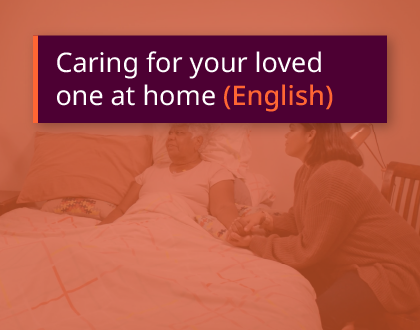Published: 14 November 2024
Transcript
[Text on screen] caring@home acknowledges the Traditional Custodians of Country throughout Australia and their connections to land, sea and community. We pay our respect to their Elders past and present and extend that respect to all Aboriginal and Torres Strait Islander people.
[Text on screen] WARNING: Aboriginal and Torres Strait Islander viewers are warned that the following video tells the story of a deceased person, as told by the family. The person’s family has given permission for caring@home to share this story.
[Music plays]
[Text on screen] Video 1 – Care for your loved one at home – caring@home logo
>>Kat Hooper (female voice over):
Bulka babulka, wanya. Welcome welcome all you mob. My name is Kat Hooper and I am a really proud Worimi woman, a descendant. I currently live, I learn, and I work and I play on the lands of the Turrabul, Jagera, and Gubbi Gubbi people.
[Text on screen] Kat Hooper, Worimi and Gubbi Gubbi descendant
Thank you for looking after your loved one, at home or on Country. You are all important in helping to keep them comfortable. Your family and community are doing such a great job.
It is not uncommon for people on their end-of-life journey to experience symptoms like pain or feeling sick in the gut.
There are many things that you can do to help your loved one. Your nurse will teach what to do and give you tip sheets with ideas.
Sometimes giving medicine is the best way to help your loved one.
When people are very sick, it is not safe to give liquid or tablet medicine. The medicine can be given under the skin instead. This is called subcutaneous medicine.
If you all wish, your nurse will show you how to give the right medicine under the skin, at the right time to help keep your loved one comfortable.
This can be better than waiting for the nurse to visit or having to drive a long way to the hospital or to the doctor.
After the nurse has taught you, you can give the medicine to your loved one right away - when they need it, even if it is the middle of the night.
The nurse will teach you all using the caring@home pack. And it has been made for Aboriginal and Torres Strait Islander families. The pack has things you need to help you give your loved one medicine under the skin. And there’s information, videos, stickers, and things to practice with. And you can ask questions.
Other families have looked after their loved ones at home or on Country and given medicines under the skin. “We could see that after we gave medicine he was peaceful and that is what we wanted.”
[Text on screen] caring@home logo www.caringathomeproject.com.au
[Text on screen] Kat Hooper is a nurse practitioner working with the caring@home team and played the role of a family member in this video. caring@home logo
caring@home for Aboriginal and Torres Strait Islander Families is funded by the Australian Government and led by Brisbane South Palliative Care Collaborative. caring@home logo
End of transcript

- Audience General public
- FormatVideo
- LanguageEnglish
- Last updated03 December 2024
